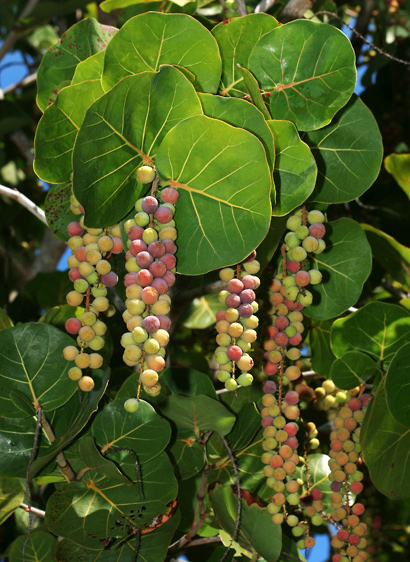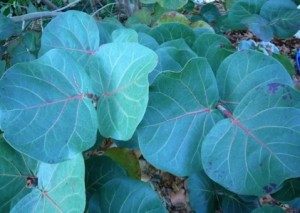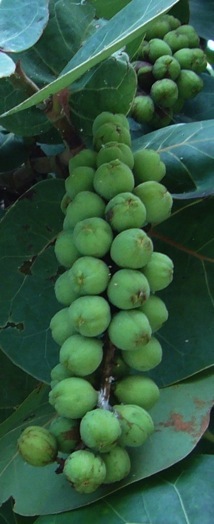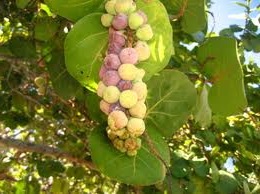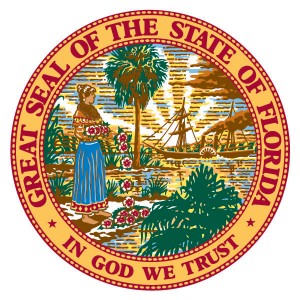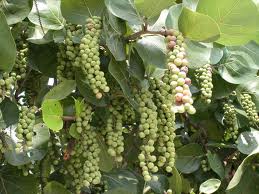Sea-Grapes: Coastal Caterer
A lifetime ago I spent many a night on a dark Florida beach near the Space Center sleeping out under Sea-Grapes. Now they would arrest you for trespassing if not threats to national security, one of the disadvantages of more people and more lawyers. But, oh what fun we had.
I can well remember the first time I saw Sea-Grapes: How exotic looking! Huge round leaves, racemes of edible fruit, large, dense stands with natural canopies underneath. Great sites for romantic rendezvous full of promise. I even wrote a few love letters on the dry leaves…composed on the spot, of course….
Sea-Grapes (Coccoloba uvifera koe-koe-LOE-buh yoo-VIFF-er-uh) are gangly, sprawling bushes or small trees found near beaches throughout tropical America and the Caribbean, including mid- and southern Florida and Bermuda. They’re also landscapes plants inland with ambitious growth. I have two species in my yard at least 90 miles outside of their accepted range, a carambola and a sea-grape. Sea-Grapes reach a maximum height of 50 feet or so under prime conditions but most are around 10 feet tall locally. The bark is smooth and yellowish. In late summer it bears green fruit, about the size of a large marble, in large skinny grape-like clusters that turn purple (think of two elephant ears and a nose, except the ears are leaves and the nose a long, skinny string of grape-like fruit.) To say the fruit has a pit is an understatement. The fruit is mostly pit. When ripe the fruit can be eaten right off the tree or used for jelly. Besides jelly, the fruit can also be made into wine. A gum or resin from the bark has been used for throat ailments and the roots used to treat dysentery.
Officially the tree is unable to survive frost. But mine has survived several and two light freezes of just 32 degrees for a few hours. It is moderately tolerant of shade, but will grow towards the sun. It’s very tolerant of salt so it is often planted to stabilize beaches. The wood of older trees is highly prized for cabinet making and boiling the wood yields a red dye. Sometimes leaves veins are red.
Dr. Julia Morton, who wrote “Wild Plants for Survival In South Florida” said of the Sea-Grape: “Shrub forming clumps on exposed beaches, or large trees… branched close to the ground acquiring broad, massive rounded head…. young leaves silky bronze, old leaves turn yellow or red and fall a few at a time. Flowers whitish, tiny, in “rattail” spikes four to 12 inches long, fruit, greenish-lavender or reddish-purple, slightly velvety, plump-oval or pear-shaped, 3/4 of an inch long, in compact, grape-like clusters. Flesh thin, juicy, acid to sweet, musky, covering single, plump, sharp-pointed, hard, brown seed with ivory tip… Leaves are useful as plates or, pinned together with twigs or thorns, can be made into hats, also serve as emergency notepaper.”
A member of the buckwheat family, Sea-Grapes were named twice. Its first botanical name was Polygonum uvifera, in 1753, reflecting that it is in the buckwheat family. The Coccoloba genus was created in that family and the Sea-Grape was slightly misnamed Coccolobis uvifera by Nickolaus Joseph von Jacquin — must not have known his Dead Latin. Linnaeus, the original namer, came back in 1759 correcting the name to Coccoloba uvifera. Coccoloba comes from “cocolobis” a type of Spanish grape; uvifera means “bearing grapes” or “like grapes.” Jacquin, incidentally, started out as a professor of Minerals and Mining at a Mining Academy in Slovakia. In 1768, he was appointed Professor of Botany and Chemistry and became director of the botanical gardens of the University of Vienna. For his work, he was knighted in 1774, made a baron in 1806. His youngest son, Emil, and his daughter, Franziska, were close friends of a hot composer of the time with several big hits, Wolfgang Mozart.
Three more things: Sea-Grapes are an important honey source, they make a good bonsai candidates, and a patent was filed in 1999 to use leaf extracts to control blood sugar levels in diabetics. Oh, and the tree is protected in Florida. It is illegal to destroy them. More specifically, you cannot harvest from public land. On Private land you need the owner’s permission. Here is the statute:
161.242 Harvesting of sea oats and sea grapes prohibited; possession prima facie evidence of violation.—
Green Deane’s “Itemized” Plant Profile
IDENTIFICATION: A seaside, warm-climate tree with huge round leaves with red veins, a shrub near the north of it range, a tree in its range.
TIME OF YEAR: Bears fruit in late summer or fall.
ENVIRONMENT: Native to coastal areas such as Florida and the West Indies. Can be grown inland in freeze-protected areas. In Florida rarely north of Daytona Beach on the east coast and St. Petersburg on the west coast. It is also found in Puerto Rico, the Virgin Islands and Hawaii. It is not reported in Mississippi but is found on the coast of Alabama. Naturalized in Mexico south to northeastern Brazil and on the Pacific south to Peru.
METHOD OF PREPARATION: Ripe red fruit out of hand off the tree or made in to jelly or wine.

